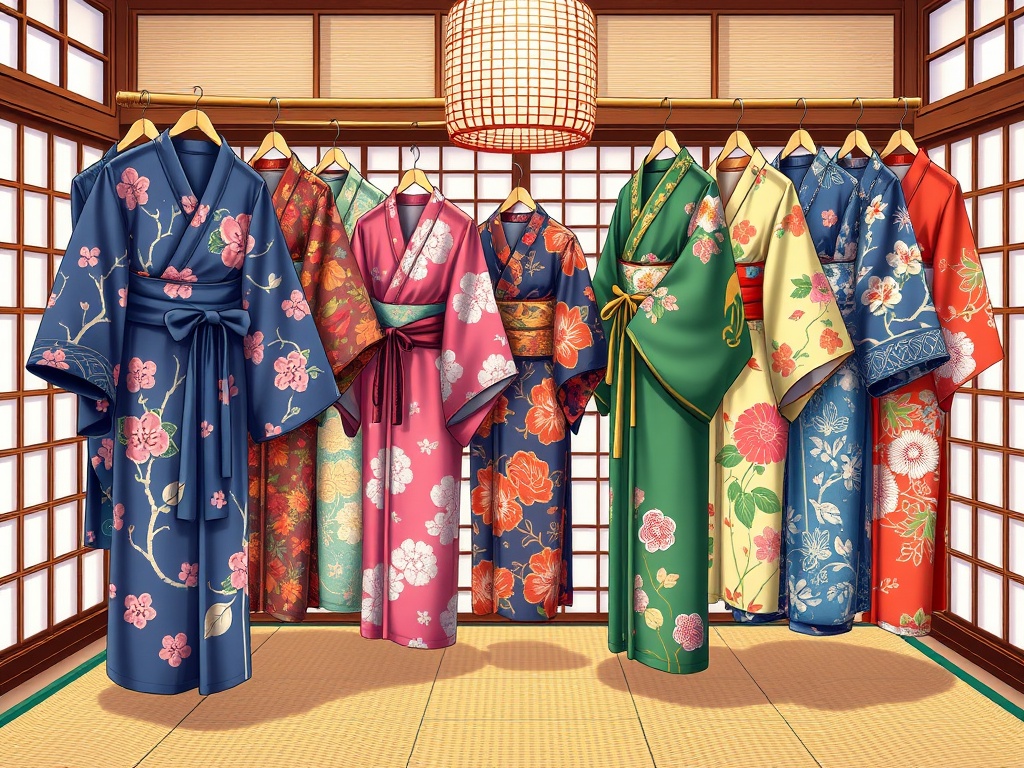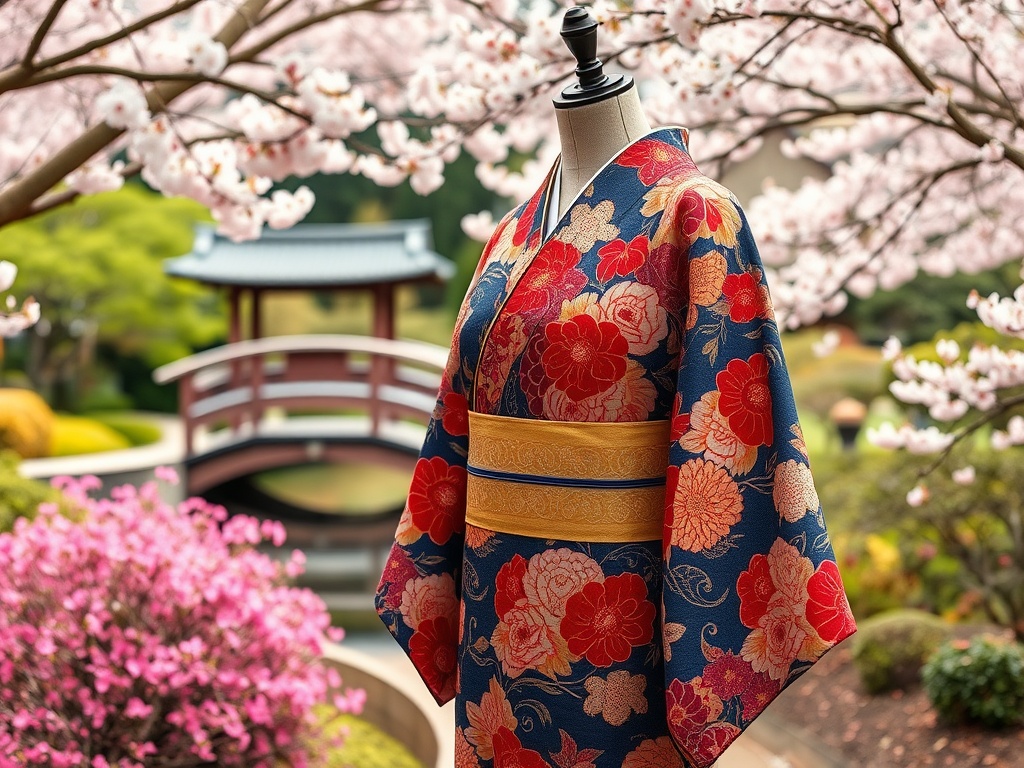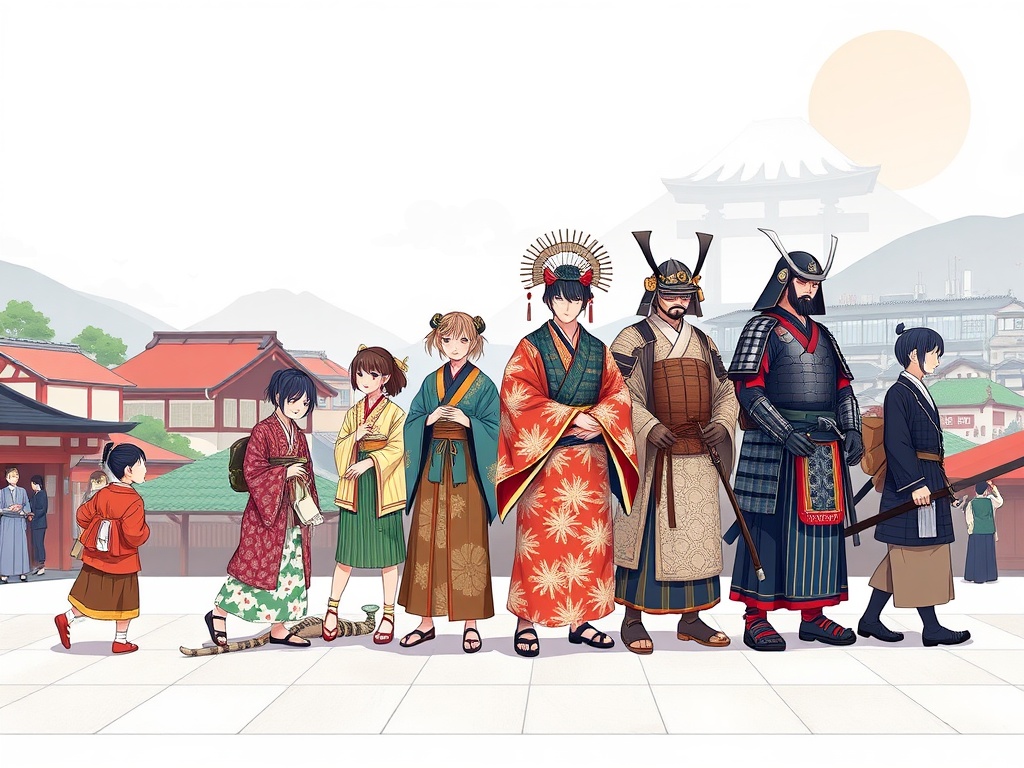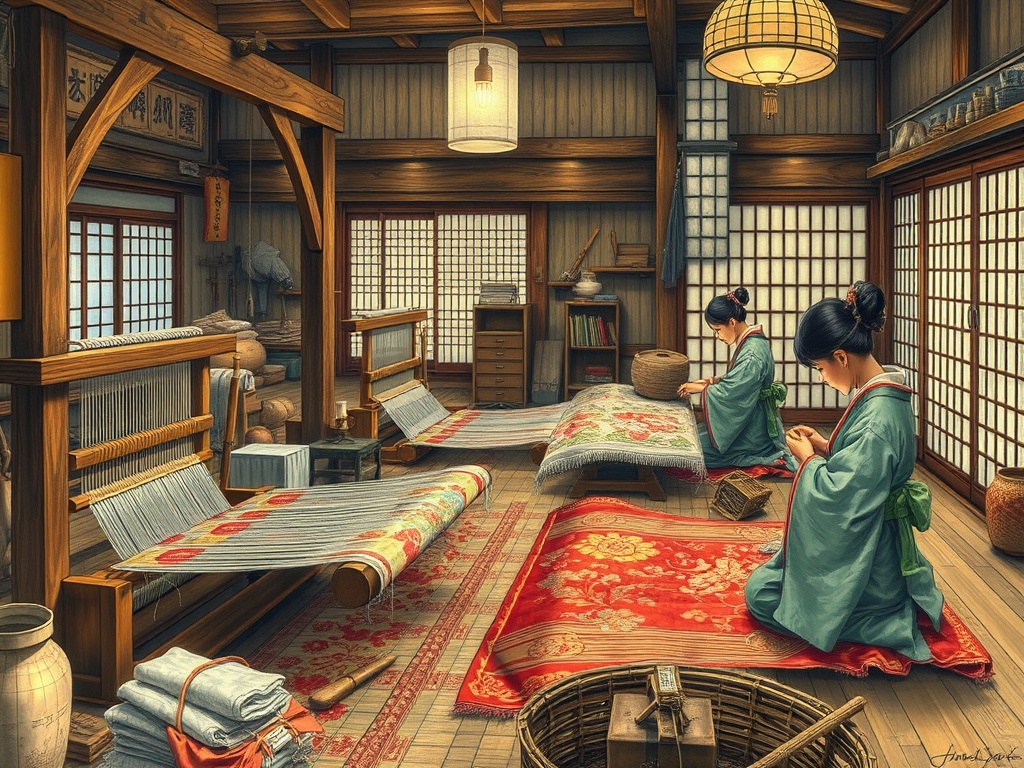Unraveling the Kimono: The Art and Elegance of Japan’s Signature Garment
Win a Free Trip to Japan!
Experience cherry blossoms and ancient temples
The kimono is more than just a piece of clothing; it is a profound symbol of Japanese culture and an exquisite canvas of art and tradition. This iconic garment, with its rich fabrics and intricate designs, has captivated the hearts of many and continues to be a significant cultural treasure. Whether you are a history buff, a fashion enthusiast, or a curious traveler, understanding the kimono offers a unique glimpse into Japan’s heritage and its people’s artistic sensibilities.
Crafting a kimono is a meticulous process that combines age-old techniques with an artistic vision. The artisans who create these garments are revered for their skill and dedication, often spending months to complete a single piece. Silk, the preferred material for kimonos, is dyed using traditional methods, ensuring that each garment has a unique and vibrant appearance. Patterns range from seasonal motifs to elaborate traditional symbols, each telling its own story. The kimono is not just sewn; it is an orchestrated masterpiece that embodies the wearer’s spirit and status.
Wearing a kimono is an experience in itself, guided by a set of etiquettes that reflect the nuances of Japanese culture. While kimonos can be worn throughout the year, certain styles are reserved for specific occasions. Here is a list of common kimono types and when they are traditionally worn:
- Furisode: Worn by unmarried women during formal events like Coming of Age Day.
- Tomesode: A formal kimono for married women, often worn at weddings.
- Yukata: A casual, unlined kimono worn during summer festivals.
- Houmongi: Suitable for social gatherings and semi-formal occasions.
Understanding the specific type and occasion for wearing a kimono not only respects tradition but enhances the cultural experience, allowing you to immerse yourself deeply in Japan’s rich tapestry.
A Tapestry of Time: Exploring the Historical Evolution of Japanese Attire
Embark on a journey through time as we unravel the fascinating evolution of Japanese attire, where each garment tells a story of its era. From the opulent court robes of the Heian period to the minimalist designs of the Edo era, Japanese clothing has been a reflection of cultural, social, and political shifts throughout history. As you explore the streets of Japan, you’ll find that the timeless elegance of traditional attire continues to influence modern fashion trends.
The Heian period (794-1185) was a time of refined elegance, where the aristocracy wore exquisite garments known as jūnihitoe, a multi-layered robe showcasing a mastery of color and texture coordination. This period marked the zenith of court fashion, reflecting the artistic and cultural sophistication of the time. Each layer of the jūnihitoe was carefully selected to symbolize seasons, emotions, or court status, creating a harmonious blend of aesthetics and symbolism that continues to inspire Japanese fashion designers today.
The Edo era (1603-1868) brought a shift towards restraint and refinement in clothing, aligning with the social order of the Tokugawa shogunate. During this time, the kimono, as we know it today, began to take shape. The simplicity of design and the use of subdued colors were indicative of the era’s preference for subtlety over ostentation. Patterns often depicted nature and folklore, with each design carrying a unique story or symbolism. This era also saw the rise of the merchant class, whose influence led to innovative textiles and designs, infusing a new vitality into traditional attire.
As you delve into the history of Japanese clothing, you’ll discover a rich tapestry woven with threads of artistry, tradition, and innovation. Whether you’re visiting a museum, attending a traditional festival, or simply strolling through the streets, the enduring charm of Japanese attire offers a captivating window into Japan’s vibrant past and dynamic present.
From Silk to Sash: The Intricate Craftsmanship Behind Traditional Japanese Fabrics
Japan’s traditional garments are renowned for their elegance and intricate designs, but what truly sets them apart is the artistry and craftsmanship that goes into creating the fabrics themselves. From the shimmering silk used for kimonos to the delicate textures of sashes, each material is a testament to the country’s rich textile heritage. For those who seek to understand the soul of Japanese attire, a journey through its fabric-making traditions promises an enlightening experience.
Silk is the crown jewel of traditional Japanese attire, known for its luxurious feel and lustrous sheen. The process of silk production is a delicate art, rooted in centuries-old techniques that have been passed down through generations. Silk weaving in Japan is not merely a craft; it is a dance of precision and patience, where each thread is meticulously dyed and woven to create stunning patterns. Artisans often draw inspiration from nature, folklore, and seasonal changes, infusing each piece with a story that reflects the harmony and beauty of the world around them.
The obi, or sash, is a vital component of traditional Japanese dress, offering both functionality and a canvas for artistic expression. These sashes vary in width, length, and design, often reflecting the wearer’s status, occasion, and even personality. The craft of creating an obi involves intricate techniques such as embroidery, weaving, and dyeing, resulting in masterpieces that can transform a simple garment into a work of art. The obi is not just an accessory; it is a symbol of grace and elegance, binding the past and present in a single, flowing ribbon.
For those captivated by the allure of traditional Japanese fabrics, visiting the textile hubs of Japan is a must. Regions such as Nishijin in Kyoto and Yuki in Ibaraki are famed for their exquisite textile production, offering a glimpse into the meticulous processes that bring these fabrics to life. Here, travelers can witness firsthand the dedication and skill of artisans, gaining a deeper appreciation for the cultural significance behind each thread. Exploring these regions is not just a journey through Japan’s textile history; it is a passage into the heart of its cultural identity.
Geisha Glamour: The Mystique and Tradition Behind the Geisha Ensemble
Step into the enchanting world of geisha, where elegance and mystique converge in a stunning display of tradition and artistry. The geisha ensemble is not merely a costume; it is a carefully curated expression of beauty, poise, and cultural heritage that has fascinated travelers and enthusiasts for centuries. As you explore the rich history and intricate details behind this iconic attire, you will gain a deeper appreciation for the dedication and artistry that define the life of a geisha.
The geisha ensemble is a symphony of layers, each contributing to the overall allure and sophistication of the attire. At the heart of this ensemble is the exquisite kimono, crafted from luxurious silk and adorned with intricate patterns that often symbolize nature or seasonal themes. The kimono’s vibrant colors and elaborate designs are a testament to the artistry involved in its creation, captivating onlookers with its beauty.
Accompanying the kimono is the obi, a wide sash that is tied at the back in an elaborate knot, adding both structure and elegance to the silhouette. Completing the ensemble are the zori sandals and tabi socks, which provide a delicate balance of comfort and style.
No geisha ensemble is complete without the transformative power of makeup and hairstyling, which play a crucial role in defining the geisha’s iconic image. The application of shironuri, a white base makeup, sets the stage for the vibrant reds and blacks that highlight the eyes and lips, creating a striking contrast that enhances the geisha’s expressive features.
The traditional nihongami hairstyle, adorned with elaborate hairpins and accessories, further elevates the geisha’s appearance, showcasing a blend of elegance and tradition. Each element of the makeup and hairstyling process is meticulously executed, reflecting the geisha’s commitment to embodying grace and sophistication.
- Kimono: An elegant silk garment with intricate patterns and vibrant colors.
- Obi: A wide sash tied in an elaborate knot for added elegance.
- Zori and Tabi: Traditional sandals and socks that complete the look.
- Shironuri Makeup: A white base with striking red and black accents.
- Nihongami Hairstyle: Elaborate styling with decorative hairpins.
As you immerse yourself in the captivating world of geisha, you will discover a rich tapestry of tradition and artistry that has stood the test of time. Whether attending a traditional tea ceremony or exploring the historic districts of Kyoto, the allure of the geisha ensemble offers a fascinating glimpse into Japan’s cultural heritage.
The Samurai’s Closet: Decoding the Armor and Attire of Japan’s Feudal Warriors
Step into the world of the samurai, Japan’s legendary warriors, whose attire was as much a reflection of their valor as it was a symbol of their status and identity. Beyond their fearsome reputation, the samurai were connoisseurs of elegance and functionality, showcasing a unique blend of artistry and pragmatism in their wardrobe. For those intrigued by the tales of feudal Japan, understanding the samurai’s closet offers a fascinating glimpse into the lives of these iconic figures and the cultural milieu they inhabited.
The armor of a samurai, known as yoroi, was both a functional battle gear and a work of art, meticulously crafted to offer protection while allowing for agility on the battlefield. Made from a combination of iron, leather, and silk, each piece was carefully assembled to form a resilient yet flexible defense. The intricate lacquerwork and colorful lacing that adorned the armor not only served decorative purposes but also indicated the samurai’s rank and allegiance. This armor was more than just a protective shell; it was a manifestation of the samurai’s honor and a testament to the skill of the artisans who crafted it.
Off the battlefield, the samurai adopted a more subdued yet still significant attire, reflecting their esteemed position in society. The kamishimo, a formal ensemble, comprised a sleeveless jacket and wide-legged trousers, often made from fine silk and adorned with the family crest. This attire was not merely about fashion; it was laden with symbolism, conveying the samurai’s loyalty and lineage. Moreover, accessories such as the katana, the samurai sword, were not only weapons but also an extension of the warrior’s spirit, embodying the code of bushido, or the way of the warrior.
For travelers exploring Japan, visiting historical sites and museums offers an unparalleled opportunity to witness authentic samurai armor and attire. These artifacts provide a tangible connection to Japan’s feudal past, inviting visitors to step back in time and experience the grandeur and mystique of the samurai era. Whether strolling through the ancient castles of Kyoto or the samurai districts of Kanazawa, the allure of the samurai’s closet promises an enriching journey into the heart of Japan’s warrior culture.
Seasonal Splendor: The Cultural Significance of Seasonal Dress in Japan
Japan is a country where the changing seasons are revered and celebrated with a unique sense of style and tradition. From the cherry blossoms of spring to the vibrant hues of autumn leaves, each season in Japan is marked by a distinct palette and atmosphere that is reflected in its traditional attire. For travelers and tourism enthusiasts, understanding the cultural significance of seasonal dress offers a deeper connection to Japan’s rich cultural landscape.
In Japan, clothing often serves as a canvas to celebrate the natural beauty and transience of the seasons. Traditional garments are adorned with motifs that reflect the blossoming of spring flowers, the cooling breezes of summer, the rustic shades of autumn, and the serene whites of winter. These motifs are not just aesthetic choices; they embody the profound appreciation for nature’s cycles, offering a glimpse into the Japanese philosophy of wabi-sabi, which finds beauty in impermanence and imperfection.
Japan’s seasonal festivals provide the perfect occasion to don traditional attire, each garment carefully chosen to complement the event. In spring, the delicate yukata is favored during the Hanami cherry blossom viewings, allowing wearers to blend seamlessly with the pastel blooms. Summer brings the vibrant colors of the matsuri festivals, where lively patterns and lightweight fabrics reflect the energetic atmosphere. As autumn arrives, the more subdued hues of the kimono are worn during Momijigari, the viewing of autumn foliage, capturing the essence of the season’s introspective beauty. Winter festivals, like the Hatsumode New Year celebrations, see attendees wrapped in warm, layered garments, often with intricate Ukiyo-e patterns depicting snow-laden landscapes.
For those exploring Japan, participating in these seasonal festivals and experiencing the traditional attire firsthand can be an enriching journey. The intersection of fashion and nature in Japan offers a unique perspective on how clothing can reflect the cultural and environmental narratives of a nation.
Modern Meets Tradition: How Contemporary Japan Embraces and Reinvents Traditional Dress
In the ever-evolving fashion landscape of Japan, the fusion of modernity and tradition has created a vibrant tapestry that captivates both locals and visitors alike. As you wander through the bustling streets of Tokyo or the serene avenues of Kyoto, the sight of traditional attire interwoven with contemporary styles is a testament to Japan’s ability to honor its past while embracing the present. For travel and tourism enthusiasts, this harmonious blend offers a unique perspective on how cultural heritage can be celebrated in today’s fast-paced world.
Japan’s fashion scene is renowned for its bold innovation and creativity, and nowhere is this more evident than in the way designers are revitalizing traditional garments. By incorporating elements of the kimono, yukata, and other classic attire into modern clothing lines, contemporary fashion houses are crafting pieces that resonate with younger generations while respecting the essence of their origins. Innovative fabrics, vibrant prints, and hybrid designs breathe new life into age-old traditions, making them relevant and appealing in today’s global fashion arena.
Beyond the realm of fashion, traditional Japanese dress is experiencing a cultural renaissance, as more individuals choose to wear these garments for everyday occasions, not just festivals or ceremonies. This resurgence is fueled by a growing appreciation for artisanal craftsmanship and sustainable fashion, as well as a desire to reconnect with cultural roots. In cities across Japan, you may find young people sporting intricately designed kimonos paired with modern accessories, or casual yukatas reimagined with contemporary flair. This trend highlights a broader movement towards cultural preservation and innovation, where tradition is not merely kept alive, but actively woven into the fabric of modern life.
For those exploring Japan, witnessing this dynamic interplay between the old and the new offers a captivating insight into the country’s cultural identity. Whether you’re attending a fashion show in the heart of Harajuku or visiting a quiet temple in Nara, the seamless integration of traditional and contemporary styles provides a rich and immersive experience, inviting you to appreciate the enduring legacy and vibrant evolution of Japanese dress.



